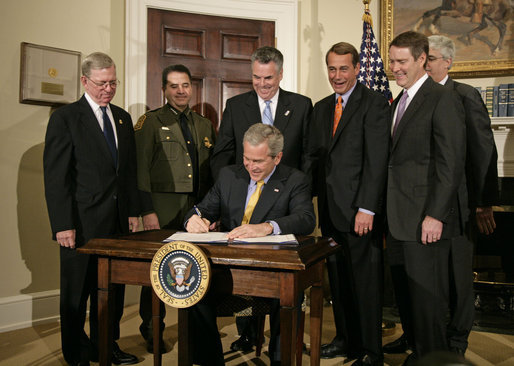
By Keanna Seabrooks, Staff Writer
Within the first two weeks of his new role in the presidency, President Donald Trump ordered the immediate construction of a U.S.-Mexican border wall.[1]
According to the president, the wall’s purpose is to combat illegal immigration and it will save millions of lives, millions of jobs, and billions of dollars.[2] While some may consider this a necessary and reasonable means to address this issue, others see it as an unnecessary expense that taxpayers may end up footing the bill for.
There are several reasons why the wall may be unnecessary. For instance, in 2006, the Secure Fence Act was signed by President George W. Bush.[3] This Act was created for the specific purpose of achieving what Trump is setting out to accomplish: the prevention of unlawful entry by unauthorized immigrants into the United States.[4]
Under this Act, Homeland Security is required to take all actions to maintain operational control over the entire international land and maritime borders of the U.S. These actions included the implementation of systematic surveillance of the internal land and maritime borders of the U.S. and physical infrastructure enhancements, such as 850 miles of additional border fencing, to prevent unlawful entry.[5] With this Act in place, the U.S. has already built a 700-mile fence, along with 36 miles of double-layered fencing, across the U.S.-Mexican Border — covering a third of the 2,000-mile border.[6]
The success of the current border fence varies depending on who is measuring the success of the government’s initiative. For instance, in a 2010 Reuters article, the fence was described as a “failure as conceived and a blemish upon [this country] internationally.” The article cited arguments claiming that smugglers and illegal immigrants experience little difficulty when encountering the fence due to its small structure, lack of razor wires to deter passage, and its abrupt end.[7]
The article also stated that “up to 500 people die every year crossing the border” because “tougher border security and the fence’s construction have forced migrants to take more dangerous, remote routes into the United States.”[8] Further, immigration experts have undercut the U.S. Border Patrol agents’ claims that the fence’s was successful in cutting the number of people trying to enter into the country as a result of the 2008 recession and unavailability of jobs.[9]
Public Radio International presented a different view of the fences and walls resulting from the Secure Fence Act. In 2015, Global Nation Editor/Reporter Monica Campbell wrote about Cecilia Balli’s online radio interview about her first encounter with the fence. Balli is a native of the Rio Grande Valley. In Balli’s interview, she described what she saw as “a scar or a cut that had been structured” that invoked an emotional force upon initially encountering the fence.[10] The article also sheds light on the fact that the current are not located in uninhabited and desolate places. Instead, the fences and walls cut through the private property of homeowners; cities, such Nogales; national parks, such as the Organ Pipe Cactus National Monument; and Indian reservations.[11]
Interestingly, statistics show a different story. From 2000 to 2012, Mexico has held the No. 1 spot for having the most illegal immigrants living in the United States.[12] Recent data, however, shows that the amount of illegal immigration from Mexico has been on a decline since 2009.[13] For example, in 2009, there were 6.4 million unauthorized Mexican immigrants living in the United States.[14] There was a decline to 6.2 million in 2012, followed by another decline to 5.8 million in 2014.[15] This declining trend could be indicative of the Secure Fence Act’s success or of other factors, such as the 2008 recession. Nevertheless, there is no evidence to suggest that either have played the most, if any, significant role in causing this trend.
The reality is that as American citizens who may initially pay for this wall, we do not have straight answers as to whether the implementation of this wall is going to be successful or whether taxpayers will be reimbursed. We have something in place that was created for the same purpose and the resulting structures have cost millions.[16] Yet, the overarching question as to whether the Secure Fence Act has been successful, even in the slightest, in bringing the nation any closer to securing its border is still unknown.
Sources
[1] https://www.nytimes.com/2017/01/25/us/politics/refugees-immigrants-wall-trump.html?_r=0
[2] http://abcnews.go.com/US/700-miles-fencing-us-mexico-border-exist/story?id=45045054
[3] http://abcnews.go.com/US/700-miles-fencing-us-mexico-border-exist/story?id=45045054
[4] https://fas.org/sgp/crs/homesec/RL33659.pdf
[5] Id.
[6] https://www.nytimes.com/interactive/2017/02/08/world/americas/before-the-wall-life-along-the-us-mexico-border.html?_r=0
[7] http://www.reuters.com/article/usa-mexico-fence-idUSN1524259520100915
[8] Id.
[9] Id. (citing the nonpartisan Pew Hispanic Center, which provided that 300,000 illegal immigrants entered the country each year between 2007 and 2009 in spite of the 2008 recession).
[10] https://www.pri.org/stories/2015-09-01/giant-border-wall-between-us-and-mexico-here-are-five-images-show-how-complicated
[11] Id.
[12] http://immigration.procon.org/view.resource.php?resourceID=000845#countries
[13] http://www.pewresearch.org/fact-tank/2016/11/03/5-facts-about-illegal-immigration-in-the-u-s
[14] Id.
[15] http://immigration.procon.org/view.resource.php?resourceID=000845#countries
[16] http://abcnews.go.com/US/700-miles-fencing-us-mexico-border-exist/story?id=45045054 (stating that the pedestrian border fences completed in fiscal year 2007 was estimated to cost about $2.8 million per mile).